18.08.2017
US Air Force Prepping Mysterious X-37B Space Plane for September Launch

The U.S. Air Force's robotic X-37B space plane sits on the Shuttle Landing Facility runway at NASA's Kennedy Space Center shortly after a May 7, 2017, landing that ended the 718-day OTV-4 mission.
-
The United States Air Force's X-37B program is readying its next robotic mini-shuttle for launch, this time atop a SpaceX Falcon 9 rocket.
The liftoff is scheduled to take place in early September, according to media reports.
Capt. Annmarie Annicelli, a U.S. Air Force spokeswoman, told Inside Outer Space: "At this time, I do not have the launch date to release."
The upcoming X-37B mission — which is known as Orbital Test Vehicle-5 (OTV-5) — will lift off from Launch Complex 39A at NASA's Kennedy Space Center in Florida.
Shuttle look-alike
The Air Force is known to own two reusable X-37B space planes, which were built by Boeing. The vehicles look like miniature versions of NASA’s now-retired space shuttle orbiter; each X-37B is 29 feet (8.8 meters) long and 9.6 feet (2.9 m) tall, and each has a wingspan of nearly 15 feet (4.6 m).
The space drone has a payload bay about the size of a pickup truck bed that can be outfitted with a robotic arm. It has a launch weight of 11,000 lbs. (4,990 kilograms) and is powered on orbit by gallium- arsenide solar cells with lithium-ion batteries.
The X-37B program is managed by the Air Force Rapid Capabilities Office to perform risk reduction, experimentation and concept of operations development for reusable space vehicle technologies.
Four previous flights
The Air Force has flown four X-37B missions to date. All of them were launched by Atlas V rockets, which are built by United Launch Alliance — a joint venture of Lockheed Martin and Boeing.
Each mission has established a new X-37B longevity record. OTV-1 lifted off on April 22, 2010, and concluded on Dec. 3, 2010, after 224 days in orbit. OTV-2 began March 5, 2011, and concluded on June 16, 2012, after 468 days on orbit.
OTV-3 chalked up nearly 675 days in orbit, finally landing on Oct. 17, 2014. And OTV-4 conducted on-orbit experiments for 718 days during its mission, extending the total number of days spent in space for the X-37B program to 2,085 days.
On May 7, 2017, OTV-4 landed at NASA's Kennedy Space Center Shuttle Landing Facility — a first for the program, as all previous missions had ended with a tarmac touchdown at Vandenberg Air Force Base in California.
It's unclear what exactly the X-37B will be doing during OTV-5, or how long the mission will last. But, according to the Air Force, one onboard OTV-5 payload is the U.S. Air Force Research Laboratory’s Advanced Structurally Embedded Thermal Spreader, or ASETS-11. This instrument will test experimental electronics and oscillating heat pipes in the long-duration space environment.
Quelle: SC
---
Update: 23.08.2017
.
Could the X-37B Space Plane be Preparing for a Mission in September
 Every additional X-37B mission has broken the previous one's longevity record. OTV-1 launched in 2010 and spent 224 days in space. OTV-2 launched the next year and more than doubled the length of the previous mission, 468 days. OTV-3 launched in 2012 and spent 675 days in space, while the most recent mission, OTV-4, narrowly missed out on two years in space when it spent 718 days in orbit. |
The United States Air Force (USAF) is preparing their secretive X-37B space plane for its fifth mission in early September. As always, most of the X-37B's payload and mission is classified, but Space.com has reported that the launch may be slated for early September.
The fifth mission of the X-37B, known as Orbital Test Vehicle-5 (OTV-5), is different from previous launches in that the space plane will be carried into orbit atop a SpaceX Falcon 9 rocket.
The previous four X-37B missions arrived in space via a Lockheed Martin-Boeing Atlas V rocket. The Falcon 9 costs about $62 million per launch due to it being partially reusable, compared to the Atlas V's $109 million per launch.
In a departure from precedent, the X-37B will be launching from NASA's Kennedy Space Center, which is adjacent to Cape Canaveral Air Force Station, the site of the previous four launches. While the launch date is believed to be in early September, USAF spokeswoman Capt. Annmarie Annicelli, told Inside Outer Space: "At this time, I do not have the launch date to release."
While most of the payload is classified, one confirmed project aboard the OTV-5 is the the US Air Force Research Laboratory's Advanced Structurally Embedded Thermal Spreader, or ASETS-11. The instrument is meant to test the effect of long-duration space missions on electronic and oscillating heat pipes.
Every additional X-37B mission has broken the previous one's longevity record. OTV-1 launched in 2010 and spent 224 days in space. OTV-2 launched the next year and more than doubled the length of the previous mission, 468 days. OTV-3 launched in 2012 and spent 675 days in space, while the most recent mission, OTV-4, narrowly missed out on two years in space when it spent 718 days in orbit.
The X-37B is 29 feet long and under 10 feet tall, with a nearly 15-foot wingspan. At launch, it weighs about 11,000 pounds and is powered by a combination of solar cells and lithium-ion batteries. The USAF owns two of them.
With a classified payload and a vague mission, the X-37B is one of the Pentagon's biggest mysteries. Theories of its purpose range from it being a spy satellite to a space weapons testing platform.
The Pentagon has consistently denied rumors that the X-37B has any nefarious purpose. It is instead meant to serve as "an experimental test program to demonstrate technologies for a reliable, reusable, unmanned space test platform for the US Air Force."
"Technologies being tested in the program include advanced guidance, navigation and control, thermal-protection systems, avionics, high-temperature structures and seals, conformal reusable insulation, lightweight electromechanical flight systems, advanced propulsion systems and autonomous orbital flight, re-entry, and landing."
Quelle: SD
---
Update: 2.09.2017
.

SpaceX conducted a Falcon 9 static test fire at Kennedy Space Center's pad 39A on Thursday, August 31, 2017 ahead of an X-37B mini-shuttle launch. Emre Kelly
A SpaceX Falcon 9 rocket slated to launch the military's X-37B mini-shuttle is primed for next week's secretive mission departing from Kennedy Space Center to low Earth orbit.
Pad 39A saw smoke and fire at 4:30 p.m. Thursday when the company successfully conducted a pre-launch check of the rocket's nine Merlin main engines and other systems, known as a static test fire.
Launch from the same pad is scheduled for Thursday during a yet-to-be specified window, according to SpaceX and the Air Force. The 156-foot-tall first stage of the Falcon 9 is expected to descend back to the area for a landing at Cape Canaveral Air Force Station's Landing Zone 1 a few minutes after liftoff.
The nearly 30-foot-long X-37B spacecraft, however, was nowhere to be seen on Thursday due to a lesson learned almost exactly a year ago when SpaceX lost a Falcon 9 rocket and satellite during a test fire at Cape Canaveral Air Force Station's Launch Complex 40. The Sept. 1 explosion destroyed a satellite that Facebook had planned to use to extend internet access in Africa. Since then, SpaceX has conducted test fires without payloads.
[SpaceX to build Dragon facility, test stand at Cape Canaveral landing zone]
[Hear that sonic boom? NASA F-18 flights underway over Space Coast]
It took the Elon Musk-led company four months to resume normal operations, marking its return to flight in January of this year. Launch Complex 40, which sits a few miles south of pad 39A, has yet to see a liftoff since the incident.
The Air Force's fifth Orbital Test Vehicle mission, or OTV-5, marks SpaceX's first attempt at launching the unmanned, Boeing-operated space plane, of which there are only two. Measuring more than 29 feet long with a 15-foot wingspan, the X-37B is about one-quarter the length of NASA's space shuttle orbiter.
Despite launching the previous four missions on United Launch Alliance Atlas V rockets, the Air Force in June revealed that SpaceX had been chosen for the latest mission to boost the 11,000-pound spacecraft to low Earth orbit.
"The ability to launch the Orbital Test Vehicle on multiple platforms will ensure a robust launch capability for our experiment designers," Randy Walden, director of the Air Force Rapid Capabilities Office, said in June, also noting that the current mission would include tests of experimental electronics and oscillating heat pipes.
“It is our goal to continue advancing the X-37B OTV so it can more fully support the growing space community," Walden said in a Thursday release.
Quelle: Florida Today
+++
Air Force preparing to launch fifth Orbital Test Vehicle mission
By Secretary of the Air Force Public Affairs / Published August 31, 2017
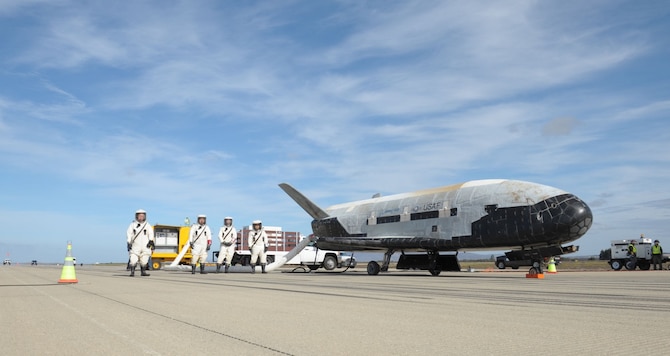
The fifth OTV mission continues to advance the X-37B’s performance and flexibility as a space technology demonstrator and host platform for experimental payloads. This mission carries small satellite ride shares and will demonstrate greater opportunities for rapid space access and on-orbit testing of emerging space technologies. Building upon the fourth mission and previous collaboration with experiment partners, this mission will host the Air Force Research Laboratory Advanced Structurally Embedded Thermal Spreader payload to test experimental electronics and oscillating heat pipe technologies in the long duration space environment.
This will be the program’s first launch on a SpaceX Falcon 9 launch vehicle. The fifth OTV mission will also be launched into, and landed from, a higher inclination orbit than prior missions to further expand the X-37B’s orbital envelope.
“The many firsts on this mission make the upcoming OTV launch a milestone for the program,” said Randy Walden, the director of the Air Force Rapid Capabilities Office. “It is our goal to continue advancing the X-37B OTV so it can more fully support the growing space community.”
The X-37B program completed its fourth mission on May 7, 2017, landing after 718 days in orbit and extending the total number of days spent in orbit to 2,085.
SUCCESSFUL STATIC FIRE TEST SETS SPACEX ON TARGET FOR POST LABOR DAY LAUNCH OF USAF X-37B MINI-SHUTTLE SEPT. 7

SpaceX conducts successful static fire test of the Falcon 9 first stage rocket at 4:30 p.m. EDT on Aug. 31, 2017 on Launch Complex 39A on NASA’s Kennedy Space Center, Fl., as seen from nearby Playalinda causeway. Liftoff of the USAF X-37B OTV-5 mini-shuttle mission is scheduled for Sept. 7, 2017. Credit: Ken Kremer/kenkremer.com
PLAYALINDA BEACH/KENNEDY SPACE CENTER, FL – Following a successful engine test firing of the Falcon 9 first stage late Thursday afternoon (Aug. 30), SpaceX is targeting a post Labor Day launch of the U.S. Air Force’s unmanned X-37B reusable mini-shuttle – a secretive technology testing spaceplane.
The brief but critical hold down engine test took place at 4:30 p.m. EDT (2030 GMT) Aug. 31 at Launch Complex 39A on NASA’s Kennedy Space Center – as witnessed live by myself and several spectators from nearby Playalinda Beach Causeway. See my photos herein.
Both SpaceX and the Air Force announced the target launch date after completion of the Aug. 31 engine test.
“Static fire test complete,” SpaceX confirmed via Twitter soon after completion of the test, “—targeting Falcon 9 launch of OTV-5 from Pad 39A at @NASAKennedy on Thursday, September 7.”
The routinely done static fire test and involves conducting a full launch dress rehearsal and countdown culminating with igniting all nine Merlin 1D first stage engines during a hold down test at the pad.

SpaceX conducts successful static fire test of the Falcon 9 first stage rocket at 4:30 p.m. EDT on Aug. 31, 2017 on Launch Complex 39A on NASA’s Kennedy Space Center, Fl., as seen from nearby Playalinda causeway. Liftoff of the USAF X-37B OTV-5 mini-shuttle mission is scheduled for Sept. 7, 2017. Credit: Ken Kremer/kenkremer.com
The Merlin’s generated a combined 1.7 million pounds of thrust and a huge exhaust plume billowing into the air from the north side flame trench during the test, which lasted several seconds.
The plume soon swirled overhead and dissipated about 10 minutes later. Ignition was accompanied by a loud roar we heard screaming out from the pad in all directions. A number of folks driving to and from Playalinda Beach had stopped to ask me what I was photographing prior to the test and stayed to witness the event.
The rocket will be lowered rolled back horizontally on the transporter erector into the SpaceX processing hangar and the spaceplane housed inside the payload fairing will be integrated on top. The full stack will then be rolled back out and erected at pad 39A.
The hold down test firing is carried out without the payload bolted on top inside the nose cone to keep it safe in the event of a catastrophic failure event such as occurred precisely 1 year ago – when a Falcon 9 blew up during fueling for similar engine test with the AMOS-6 satellite resulting in destruction of the rocket as well as the customers satellite hardware at pad 40.
The exact launch time had been a closely guarded secret – until this evening.
The X-37B launch is apparently lunchtime Thursday, September 7 at 12 PM – 12:01 PM, according to a Facebook post by the U.S. Air Force Space Command and the 45th Space Wing at Patrick Air Force Base, Fla., posted Friday evening.
“The Air Force Rapid Capabilities Office is undergoing final launch preparations for the fifth mission of the X-37B Orbital Test Vehicle [OTV],” the Secretary of the Air Force Public Affairs announced. “The OTV is scheduled to launch on Sept. 7, 2017, onboard a SpaceX Falcon 9 launch vehicle.

The USAF X-37B Orbital Test Vehicle is set for blastoff on Sept. 7, 2017, onboard a SpaceX Falcon 9 launch vehicle from Launch Complex 39A (LC-39A) at Kennedy Space Center in Florida. Photo: Boeing/USAF
The X-37B will be launched for the fifth time on the OTV-5 mission atop a SpaceX Falcon 9 on Sept. 7 from Launch Complex 39A on the Kennedy Space Center Florida into low Earth orbit.
The Boeing-built X-37B is processed for flight at KSC using refurbished NASA space shuttle processing facilities now dedicated to the reusable mini-shuttle, also known as the Orbital Test Vehicle (OTV). It launches vertically like a satellite but lands horizontally like an airplane and functions as a reliable and reusable space test platform for the U.S. Air Force.
But in another first, the OTV-5 mission marks the first launch of an X-37B spaceplane by SpaceX.
All four prior OTV missions launched on the United Launch Alliance Atlas V and ended with runway landings in either California of Florida.
“The many firsts on this mission make the upcoming OTV launch a milestone for the program,” said Randy Walden, the director of the Air Force Rapid Capabilities Office.
“It is our goal to continue advancing the X-37B OTV so it can more fully support the growing space community.”
The OTV-4 mission launched on the ULA Atlas V on May 20, 2015 from Space Launch Complex-41, on Cape Canaveral Air Force Station.

Blastoff of the X-37B spaceplane on United Launch Alliance (ULA) Atlas V rocket with the OTV-4 AFSPC-5 satellite for the U.S. Air Force at 11:05 a.m. EDT, May 20, 2015 from Space Launch Complex-41. Credit: Ken Kremer/kenkremer.com
After spending a record setting 718 days in orbit, the X-37B program completed its fourth mission with a runway landing back at KSC’s Shuttle Landing Facility on May 7, 2017. Overall OTV’s have spent a total of 2,085 days in orbit.

SpaceX conducts successful static fire test of the Falcon 9 first stage rocket at 4:30 p.m. EDT on Aug. 31, 2017 on Launch Complex 39A on NASA’s Kennedy Space Center, Fl., as seen from nearby Playalinda causeway. Liftoff of the USAF X-37B OTV-5 mini-shuttle mission is scheduled for Sept. 7, 2017. Credit: Ken Kremer/kenkremer.com
Playalinda Beach is located just 4 miles north of pad 39A and offers an excellent launch viewing location for the OTV-5 mission – if officials allow it to be open to the public.
The engine test comes at the end of a very busy August with a trio of Florida Space Coast launches plus a Total Solar ‘Eclipse Across America’ sandwiched in between.
Also noteworthy is that OTV-5 will be launched into a higher inclination orbit compared to the prior four, serve as a technology testbed for multiple research payloads and will also somehow deploy several small satellites or cubesats.
“The fifth OTV mission continues to advance the X-37B’s performance and flexibility as a space technology demonstrator and host platform for experimental payloads,” the USAF said in a statement.
“This mission carries small satellite ride shares and will demonstrate greater opportunities for rapid space access and on-orbit testing of emerging space technologies. Building upon the fourth mission and previous collaboration with experiment partners, this mission will host the Air Force Research Laboratory Advanced Structurally Embedded Thermal Spreader payload to test experimental electronics and oscillating heat pipe technologies in the long duration space environment.”

SpaceX conducts successful static fire test of the Falcon 9 first stage rocket at 4:30 p.m. EDT on Aug. 31, 2017 on Launch Complex 39A on NASA’s Kennedy Space Center, Fl., as seen from nearby Playalinda causeway. Liftoff of the USAF X-37B OTV-5 mini-shuttle mission is scheduled for Sept. 7, 2017. Credit: Ken Kremer/kenkremer.com
SpaceX will also attempt another land landing of the 156-foot-tall Falcon 9 first stage back at Landing Zone-1 (LZ-1) at the Cape.
The Falcon 9 first stage is equipped with a quartet of landing legs and grid fins to enable the rocket recycling plan.
“The fifth OTV mission will also be launched into, and landed from, a higher inclination orbit than prior missions to further expand the X-37B’s orbital envelope.”
The daylight first stage precision guided landing should offer spectators a thrilling up close view of the rocket reusability technology envisioned by SpaceX’s billionaire CEO Elon Musk to drastically slash the high costs of launching to space.
The 11,000 pound (4990 kg) state-of -the art reusable OTV space plane is about a quarter the size of a NASA space shuttle. The vehicle measures 29 ft 3 in (8.9 m) in length with a wingspan of 14 ft 11 in (4.5 m).
The X-37B was originally developed by NASA but was transferred to the Defense Advanced Research Projects Agency (DARPA) in 2004.
Since then most but not all of the spaceplane’s goals have been shrouded in secrecy.

SpaceX conducts successful static fire test of the Falcon 9 first stage rocket at 4:30 p.m. EDT on Aug. 31, 2017 on Launch Complex 39A on NASA’s Kennedy Space Center, Fl., as seen from nearby Playalinda causeway. Liftoff of the USAF X-37B OTV-5 mini-shuttle mission is scheduled for Sept. 7, 2017. Credit: Ken Kremer/kenkremer.com
Watch for Ken’s continuing onsite X-37B OTV-5 and NASA mission reports direct from the Kennedy Space Center and Cape Canaveral Air Force Station, Florida.
Stay tuned here for Ken’s continuing Earth and Planetary science and human spaceflight news.

The X-37B Orbital Test Vehicle taxiing on the flightline on March 30th, 2010, at the Astrotech facility in Titusville, Florida. Credit: USAF
Quelle: UT
---
Update: 6.09.2017
.
As Irma approaches, weather so-so for SpaceX Falcon 9 launch with X-37B mini-shuttle
Weather conditions are expected to be increasingly unfavorable for this week's launch of a secretive mini-shuttle on a SpaceX Falcon 9 rocket from Kennedy Space Center as Hurricane Irma bears down on Florida.
Thursday's attempt to launch the space plane from pad 39A during a yet-to-be-announced window will face a 50 percent chance of violating weather rules, according to the Air Force's 45th Weather Squadron.
"Hurricane Irma is forecast to be approximately 950 miles southeast of the Spaceport during Thursday’s launch attempt, so while Irma certainly bears watching, it will not be a factor in Thursday’s weather," forecasters said in a Tuesday update, noting that thick and cumulus clouds were the primary concerns.
A delay to Friday would diminish launch probabilities even further to 40 percent "go" as Irma churns about 650 miles to the southeast of the Eastern Range, which encompasses Kennedy Space Center and Cape Canaveral Air Force Station. An increase in low-level winds would be added to the list of concerns.
"The pressure gradient between the high pressure area behind the frontal boundary and Hurricane Irma will begin to tighten," forecasters said. "This will create northeast low-level winds that will strengthen, becoming 20 mph by the end of the launch window."
The rocket's first stage is expected to dive back down to Cape Canaveral Air Force Station's Landing Zone 1 a few minutes after liftoff, generating a powerful sonic boom on the way.
This launch – the Air Force's fifth Orbital Test Vehicle mission, or OTV-5 – marks SpaceX's first attempt at boosting the 11,000-pound unmanned space plane to low Earth orbit. There are only two of the Boeing-built spacecraft, which each measure about 29 feet long with a 15-foot wingspan.
The secretive program is based in two former space shuttle hangars near the Vehicle Assembly Building at KSC, allowing both spacecraft to land at the nearby Shuttle Landing Facility. The last mission, which ended in May, spent a record-breaking 718 days in space.
But what exactly the X-37B does in orbit is classified – aside from launch and landing dates and minor operational details, the Air Force provides little on the vehicle's purpose. This mission is expected to carry some experimental payloads and deliver small satellites, along with testing electronics and heat pipe technologies over long-duration spaceflight.
"The fifth OTV mission continues to advance the X-37B’s performance and flexibility as a space technology demonstrator and host platform for experimental payloads," the Air Force said in a release last week. "This mission carries small satellite ride shares and will demonstrate greater opportunities for rapid space access and on-orbit testing of emerging space technologies."
Both spacecraft have spent a combined 2,085 days in space.
Quelle: Florida Today
---
Update: 7.09.2017 / 8.15 MESZ
.
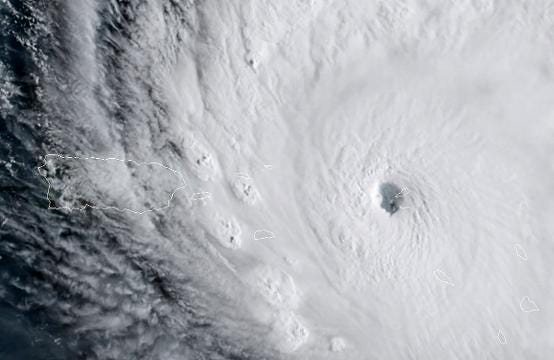
NOAA has been sending 'Hurricane Hunter' aircraft over the Atlantic to get a closer look at Hurricane Irma. Take a flight with the team as they capture the powerful storm from the outside in. Sept. 3, 2017. USA TODAY
Staff meetings and early preparations for the potential arrival of Hurricane Irma are underway at NASA's Kennedy Space Center, which saw the activation of its hurricane alert scale Wednesday morning.
The agency's Florida spaceport entered the fourth phase of Hurricane Condition, also known as HURCON, at 9 a.m. Wednesday morning, according to a NASA public affairs officer. The activation means managers are developing preliminary plans to weather the storm, including the establishment of "rideout teams" to stay behind in the event of closures or evacuations.
Rideout teams will include senior-level managers, a NASA emergency management officer, as well as representatives from contractors, commercial partners and other related organizations. SpaceX and Boeing, for example, would leave behind representatives as both have presences on KSC property.
No closures have been scheduled and a senior-level meeting is expected Thursday morning.
[As Irma approaches, weather so-so for SpaceX Falcon 9 launch with X-37B]
[The mysterious X-37B: What's the Air Force's mini-shuttle all about?]
The last time Kennedy Space Center activated a HURCON status was when Hurricane Matthew brushed by the Space Coast in October 2016.
Officials at Cape Canaveral Air Force Station, meanwhile, declared a HURCON V status for the base that shares the Eastern Range with KSC. The Air Force's hurricane alert system differs from NASA's.
The fifth phase, according to a statement from the 45th Space Wing, means surface winds in excess of 58 mph could arrive within 96 hours.
"During HURCON V, 45th Space Wing will begin precautionary preparations to secure property and any launch infrastructure that may be exposed to storm conditions," the statement reads. "All hurricane response teams are now on telephone standby and teams will soon begin to store outdoor items that could become projectiles in a storm."
But preparing for Irma isn't the spaceport's only near-term concern – a SpaceX Falcon 9 rocket topped with a secretive X-37B mini-shuttle is scheduled to launch from KSC's pad 39A Thursday morning. According to Air Force weather forecasters, the fifth Orbital Test Vehicle mission, labeled OTV-5, faces 50 percent "go" conditions as Irma churns 900 miles to the southeast of the Eastern Range.
The Falcon 9 rocket is expected to launch during a window that opens at 9:50 a.m. and closes at 2:55 p.m. A first stage landing at nearby Landing Zone 1 is expected a few minutes after liftoff, which should prompt a sonic boom to reverberate across the Space Coast.
If the mission scrubs to Friday, conditions are expected to worsen to 40 percent "go" as Irma closes in to within 600 miles of the Cape.
Quelle: Florida Today
+++


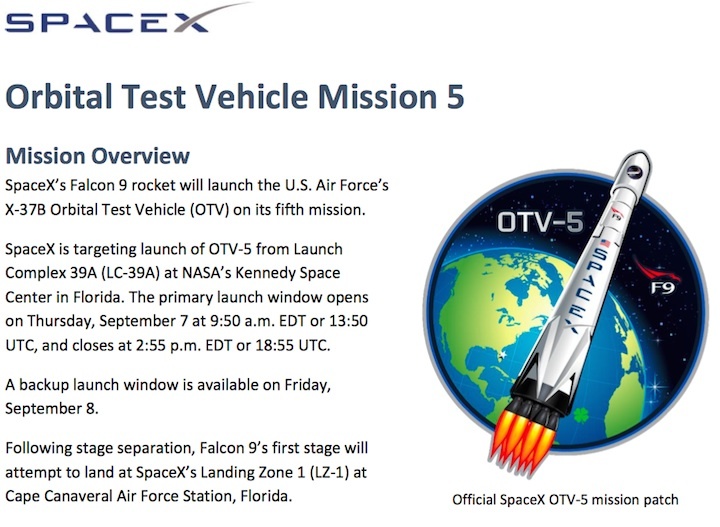


Quelle: SpaceX
+++
Update: 16.00 MESZ
.
Frams von LIVE-Start:
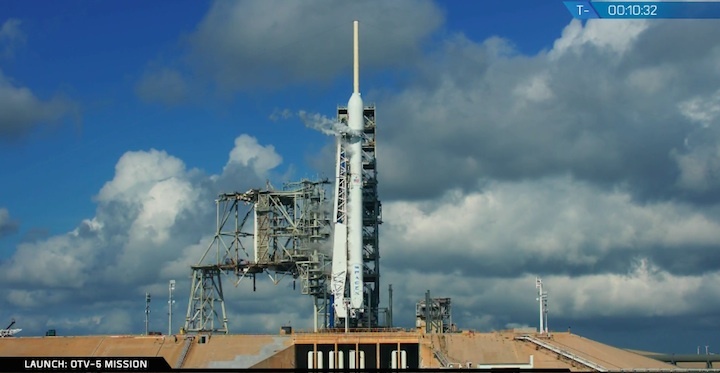


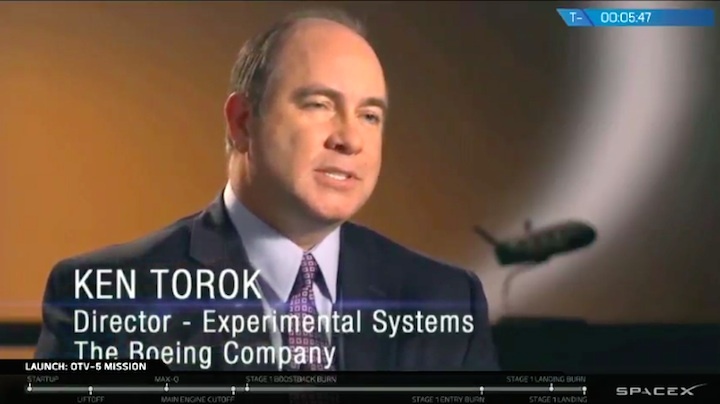
















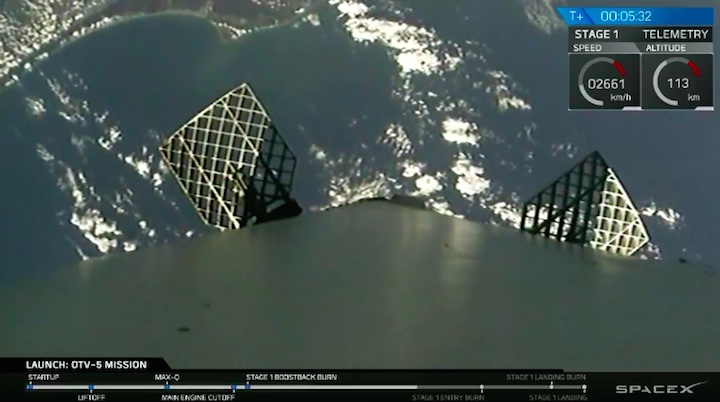








Quelle: SpaceX
+++
45th SW launches 5th OTV mission
The 45th Space Wing successfully launched a SpaceX Falcon 9 launch vehicle Sept. 7, 2017, from Kennedy Space Center’s Launch Complex 39A.
Approximately eight minutes after the launch, SpaceX successfully landed the Falcon 9 first-stage booster at Landing Zone 1 on Cape Canaveral Air Force Station.
Brig. Gen. Wayne Monteith, the 45th SW commander, thanked the entire OTV-5 mission team for their efforts in ensuring a successful launch.
“I’m incredibly proud of the 45th Space Wing’s contributions to the X-37B program,” Monteith said. “This marks the fifth successful launch of the OTV and its first onboard a Falcon 9. A strong relationship with our mission partners, such as the Air Force Rapid Capabilities Office, is vital toward maintaining the Eastern Range as the world’s premiere gateway to space.”
The X-37B Orbital Test Vehicle is led by the Air Force Rapid Capabilities Office, with operations overseen by Air Force Space Command’s 3rd Space Experimentation Squadron. The OTV is designed to demonstrate reusable spacecraft technologies for America’s future in space and operate experiments, which can be returned to and examined on Earth.
Quelle: USAF
